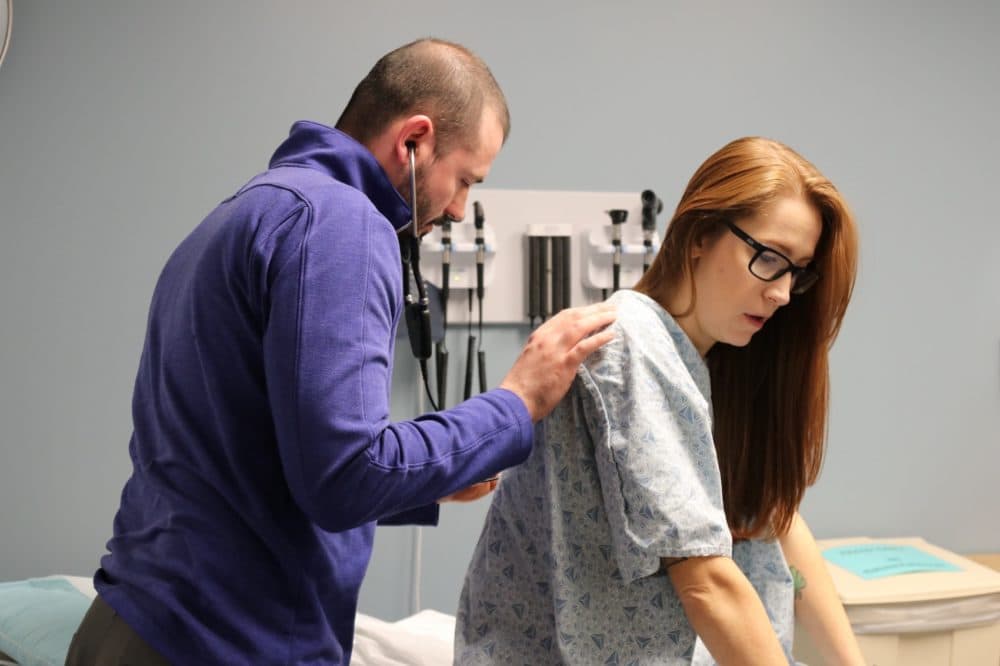Advertisement
Medical Schools Are Changing The Way They Teach Treatment For Pain, Opioid Addiction

With Meghna Chakrabarti
We visit a med school that's teaching a new generation of doctors to start with empathy as they rethink their entire approach to treating patients with opioid addiction disorders.
Guests
Dr. Michael Englesbe, professor of surgery at the University of Michigan in the Section of Transplantation Surgery. (@MichaelEnglesbe)
Dr. Kelly Clark, past president of the American Society of Addiction Medicine. Founder of Addiction Crisis Solutions, a company focused on transforming addiction care into evidence-based, cost-effective practice. (@kellyclarkmd)
From The Reading List
Association of American Medical Colleges: "The delicate balance between treating pain and preventing addiction" — "Cortney Lovell woke up in her beat-up hatchback car in rural upstate New York the morning of February 9, 2008. She was cold and confused. She hadn’t expected to wake up at all.
"Lovell was 19 years old and had decided the night before to take the rest of her heroin and cocaine. Battling substance use disorder (SUD) and running from 27 different felony charges, she didn’t know what else to do.
"'I was so hopeless, so full of despair,' said Lovell, now 30. 'I had resigned myself to the idea that I would live the rest of my days and die addicted to opioids, and that was going to be it for me.'
"But against all odds, Lovell lived. She began to drive, leaving the first tire tracks on a fresh bed of snow.
"'For the first time in years, I had this open feeling,' Lovell said. 'I thought, "Maybe I can have a blank slate now." '
"She drove to the only place she knew she could always go back to: home. In her parents’ kitchen, she was arrested and taken to a county jail, where she endured opioid withdrawal and was later able to thrive through a process of recovery with treatment and community support."
Advertisement
American Journal of Managed Care: "Dr Kelly Clark: Addiction Is a Chronic Brain Disease" — "Prescription drug abuse is an epidemic in the US and a chronic brain disease, but it is not treated the way other chronic conditions are, said Kelly J. Clark, MD, MBA, president elect of the American Society of Addiction Medicine."
New York Times: "Most Doctors Are Ill-Equipped to Deal With the Opioid Epidemic. Few Medical Schools Teach Addiction." — "To the medical students, the patient was a conundrum.
"According to his chart, he had residual pain from a leg injury sustained while working on a train track. Now he wanted an opioid stronger than the Percocet he’d been prescribed. So why did his urine test positive for two other drugs — cocaine and hydromorphone, a powerful opioid that doctors had not ordered?
"It was up to Clark Yin, 29, to figure out what was really going on with Chris McQ, 58 — as seven other third-year medical students and two instructors watched.
"'How are you going to have a conversation around the patient’s positive tox screen results?' asked Dr. Lidya H. Wlasiuk, who teaches addiction awareness and interventions here at Boston University School of Medicine.
"Mr. Yin threw up his hands. 'I have no idea,' he admitted.
"Chris McQ is a fictional case study created by Dr. Wlasiuk, brought to life for this class by Ric Mauré, a keyboard player who also works as a standardized patient — trained to represent a real patient, to help medical students practice diagnostic and communication skills. The assignment today: grappling with the delicate art and science of managing a chronic pain patient who might be tipping into a substance use disorder."
STAT: "Opinion: Deregulating buprenorphine prescribing for opioid use disorder will save lives" — "The day each of us received our licenses from the Drug Enforcement Administration, we were able to write prescriptions for oxycodone and fentanyl, two drugs that have fueled the opioid overdose epidemic. But we couldn’t prescribe buprenorphine, a far safer partial opioid that is an effective treatment for opioid use disorder, without getting additional training, a special license with a number that begins with 'X,' and agreeing to allow DEA agents to inspect our patient records.
"That doesn’t make sense to us, especially as our country is in the midst of an overdose epidemic.
"Opioid use disorder can cause tremendous suffering for people with it and their families. As physicians who specialize in addiction medicine, we have seen the transformative effects of treatment with medications such as buprenorphine. When combined with naloxone, it’s sold as Suboxone. People who take it report that they no longer feel compelled to use illicit opioids. They can focus on their recovery and on restoring their relationships."
Allison Pohle produced this show for broadcast.
Correction: Our broadcast incorrectly identified the Association of American Medical Colleges. We regret the error.
This program aired on May 28, 2019.